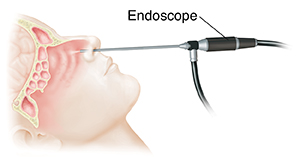Understanding Endoscopic Endonasal Surgery
Endoscopic endonasal surgery is a type of procedure to treat problems, such as a tumor, in the front or bottom of the brain or top of the spinal cord. A surgeon puts a thin tube (endoscope) and tiny tools through the nose to do the surgery, instead of cutting through the skull (open surgery). This lets them reach areas that are hard to access in other ways. Your recovery will also be faster and less painful than with open surgery.

How to say it
EHN-doh-skah-pihk EHN-doh-nay-zuhl
Why endoscopic endonasal surgery is done
This kind of surgery may be done to:
-
Remove a tumor or other growth in the pituitary gland, sinuses, or brain.
-
Stop leakage of cerebrospinal fluid (CSF) in the area.
-
Treat an infection that won’t go away.
-
Treat problems affecting the optic nerve.
-
Repair a problem with blood vessels in the brain (called arteriovenous malformation).
How endoscopic endonasal surgery is done
Surgery is done in a hospital and may take several hours. During the procedure:
-
You'll lie on a table. You'll be given medicine (anesthesia) that lets you sleep through the procedure.
-
The surgeon puts an endoscope into your nose and sinuses. The narrow scope fits through natural gaps in these areas. The camera sends images to a computer screen.
-
The surgeon will also put small tools through your nose. This is often done through the same nostril as the endoscope. They'll use the tools to remove a tumor or treat the problem area as needed. The surgeon may remove or cut other tissue or parts of bone on the underside of the skull.
-
When the surgery is done, they'll remove the tools and endoscope. They may then fill your nose and sinuses with nasal packing. This material will be removed in 1 to 2 days. You’ll be in the hospital one or more nights after surgery.
A newer technique offers 3-D viewing to give the surgeon a better understanding of the space and what they are seeing on a computer screen.
Risks of endoscopic endonasal surgery
The risks of endoscopic endonasal surgery include:
-
Poor healing of the surgery site.
-
CSF leaking from the nose.
-
Air getting trapped inside the head (pneumocephalus).
-
Excess bleeding.
-
Blood clot in the head.
-
Infection inside the head, including the covering of the brain and spinal cord.
-
Damage to blood vessels and nerves in the area.
-
Pain.
-
Crusting of the inside of the nose and sinuses that lasts for weeks or months.
-
Trouble breathing through the nose.
-
Reaction to anesthesia.
Online Medical Reviewer:
Esther Adler
Online Medical Reviewer:
Raymond Kent Turley BSN MSN RN
Online Medical Reviewer:
Sravani Chintapalli Researcher
Date Last Reviewed:
4/1/2025
© 2000-2025 The StayWell Company, LLC. All rights reserved. This information is not intended as a substitute for professional medical care. Always follow your healthcare professional's instructions.